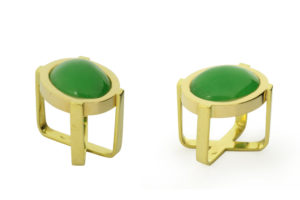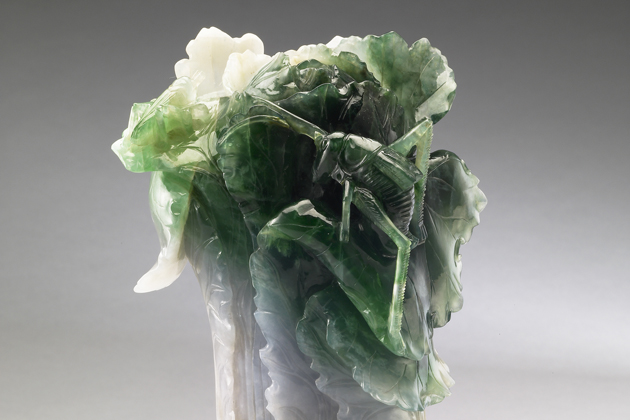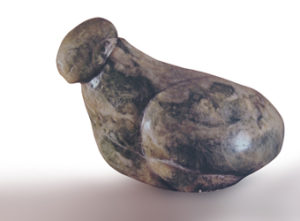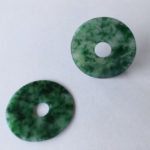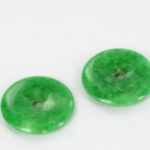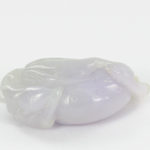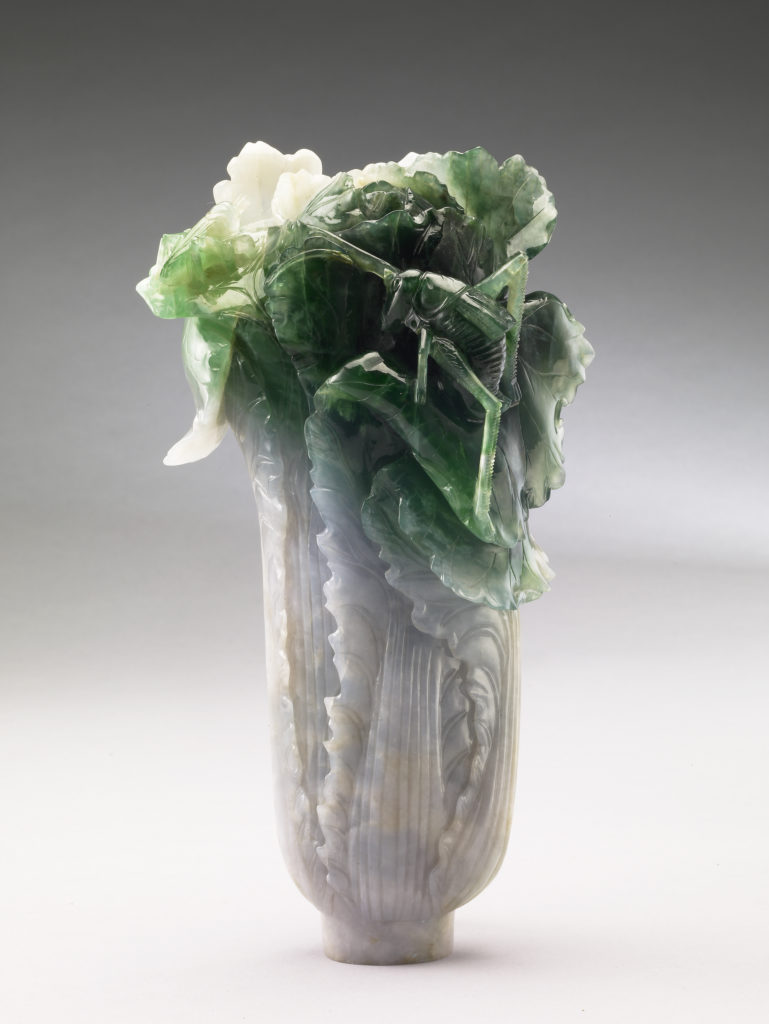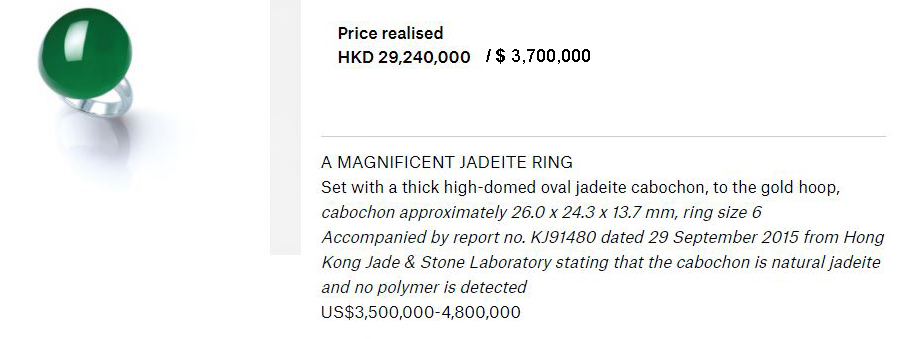« Le jade est l’image de la bonté, parce qu’il est doux au toucher et onctueux ; de la prudence, parce que ses veines sont fines, compactes et qu’il est solide… »
Confucius
(551-479 AV J.-C.)
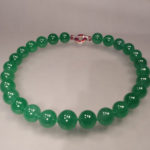 Confucius ajoute que le jade est symbole de sincérité parce que son éclat n’est pas voilé par ses défauts ni ses défauts par son éclat.
Confucius ajoute que le jade est symbole de sincérité parce que son éclat n’est pas voilé par ses défauts ni ses défauts par son éclat.
Le jade est, en tous cas, une des plus anciennes pierres précieuses connues de l’homme. On retrouve des objets taillés (pointe de flèche, objets de culte ou de parure) sur de nombreux sites préhistoriques en Asie.
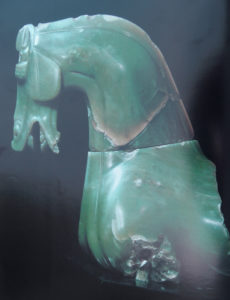
OLYMPUS DIGITAL CAMERA
Les principaux gisements de jade se trouvent en Chine, en Birmanie (Myanmar), en Nouvelle-Zélande, en Russie, au Guatemala et dans les Alpes Suisses.
Son nom provient de l’espagnol « piedra de ijada », pierre du rein car les amérindiens l’utilisait pour soigner les reins. En raison de cet effet bénéfique (?) sur les reins, la pierre était également appelée « lapis nephreticus », qui a donné le terme néphrite.
C’est en Chine que le jade a fourni la matière aux plus belles parures et aux plus beaux objets d’art, une préciosité reconnue depuis le néolithique et qui le place en tête de toutes les matières précieuses, bien au-dessus de l’or.
En Chine, jade se dit Yù « 玉 », qui signifie également précieux.
Sculpture représentant un oiseau, époque néolithique, c’est l’une des sculptures en jade les plus anciennes au monde.
(Avery Brundage Collection, San Francisco).
Tout au long de l’histoire culturelle de l’empire chinois, le jade a eu une place particulière, comparable à celles de l’or et du diamant dans le monde occidental.
Non seulement le jade était utilisé pour les objets religieux ou décoratifs les plus précieux mais il entrait également dans le mobilier funéraire des tombes de la famille impériale. Aujourd’hui encore, cette gemme est symbole de beauté, de droiture et de préciosité. Elle représente également les vertus confucéennes de sagesse, de justice, de compassion, de courage, d’humilité et même de féminité.
Du côté des gisements d’Amérique centrale, à l’époque précolombienne, les Mayas, les Olmèques et les Aztèques tenaient également le jade en plus haute estime que l’or.
Les Maoris de Nouvelle-Zélande taillaient des armes et des instruments de culte en jade local depuis des temps immémoriaux, une tradition qui perdure aujourd’hui.
Qu’est ce que le jade ?
Le jade est pluriel car ce nom recouvre deux minéraux proches par l’aspect mais pourtant éloignés du point de vue minéralogique. La jadéite et la néphrite. Ce n’est qu’au début du 19ème siècle que les minéralogistes et les gemmologistes ont pu les différencier malgré leur ressemblance en termes de dureté et de propriétés physiques.
Jadéite et jade néphrite ont la même résistance et consistent en un agrégat dense de matières granuleuses. Cependant ils diffèrent dans leur composition chimique et dans leurs couleurs.
La néphrite est un silicate calco-magnésien, son indice de réfraction est de 1,62 et son poli est un peu moins fin que celui de la jadéite. Sa densité est également plus faible. Sa couleur va du vert moyen au vert épinard et peut prendre des couleurs blanches jaunâtres à ocrées.
2 disques de jade néphrite (collection personnelle)
La jadéite est un silicate d’alumine et de sodium, son indice de réfraction est de 1,66, son poli est très fin et brillant. Plus rare et plus résistante, elle offre de nombreuses couleurs : du magnifique et très prisé vert printemps, au blanc, rose, mauve, noir et ocre à brun.
Seules les jadéites les plus précieuses présentent une couleur homogène, le jade présente souvent des veines, des taches, des réseaux de couleur dont les sculpteurs les plus doués ont pu tirer profit pour leurs motifs (comme pour le fameux chou du musée de Taipeh-voir ci-dessous).
Chou et 2 insectes, jadéite, époque Qing, ( ) National Palace Museum, Taipeh
J’ai découvert le jade lors de mon premier voyage en Chine, en 1987, avant d’entreprendre des études de gemmologie. Sur le marché de Dali, dans le Yunnan, on me proposa du jade. J’acquis alors, à peu de frais, 2 disques de néphrite, (photo plus haut dans l’article), un de jadéite blanche moucheté vert et un bracelet blanc et vert qui s’avéra être du marbre teinté, comme cela arrive souvent. Son faible prix était en lui-même la preuve de sa faible valeur.
Plus tard, pendant mes études de gemmologie, j’ai pu acquérir deux disques de jadéite, vert vif (voir également plus haut), ils me coûtèrent presqu’un trimestre de cours !
Il paraît raisonnable d’exiger une facture pour tout achat, et, si possible un certificat de laboratoire pour une pièce dépassant 5000 euros.
Valeur du jade
Aujourd’hui, les plus belles jadéites proviennent du Myanmar. Là, lors de la foire aux pierres, des blocs de jade de toutes tailles sont mis aux enchères. Lors de l’achat d’un brut, les négociants doivent compter sur la chance car les nodules, blocs ou fragments sont vendus entiers ou en tranches épaisses, et seule une petite « fenêtre » aura pu être polie pour voir à l’intérieur du cristal. L’acquéreur voit donc à peine ce qu’il y a à l’intérieur du nodule : soit du jade d’une belle couleur, homogène et précieux, soit un matériau tacheté ou veiné de moindre valeur.
En général, la valeur du jade est déterminée par sa couleur et l’intensité de celle-ci, sa vivacité, sa texture, sa pureté et sa transparence.
En ce qui concerne le jade vert, les experts différencient 7 qualités principales, du vert intense et uniforme du jade impérial, jusqu’à des verts mouchetés en passant par le vert pomme et le vert épinard.
Ces nuances s’inscrivent dans un continuum et sont difficiles à reconnaître par un œil non entraîné.
Aux USA et en Europe, le vert émeraude, le vert épinard et le vert pomme sont les plus appréciés. En Asie, le blanc pur ou un beau jaune avec une nuance de rose sont particulièrement appréciés. Pour les bijoux, les nuances violettes du jade lavande sont très demandées.
Cependant le vert émeraude du jade impérial, très rare, transparent sur les bords et qui offre une couleur profonde atteint des sommets. Cela a malheureusement entrainé des traitements d’améliorations de pierres de mauvaise qualité qui ont pu être baignées (teintes) ou traitées avec des colles et il vaut donc mieux faire ses achats dans des maisons de bonne réputation.
Pour conclure sur le chapitre de la valeur marchande, voici une bague, d’une grande simplicité, montée avec un jade en demi-sphère, à la cristallisation parfaite.
Son prix a dépassé 3, 7 millions de Dollars US en 2015.
Enfin, voici une création originale de Jean Grisoni, mettant en valeur un cabochon de jade du Vietnam et vendue récemment par la galerie.
